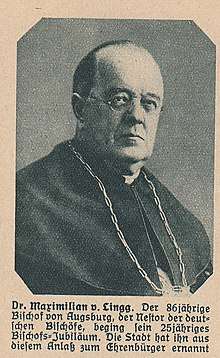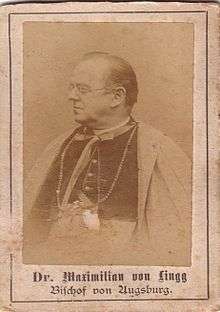Maximilian von Lingg
Maximilian Joseph Lingg, from 1902 Ritter von Lingg (* 8 March 1842 in Nesselwang; † 31 May 1930 in Füssen), was the 78th Bishop of Augsburg.


Life
Max Joseph Lingg was born on March 8, 1842, the eldest child of the baker Johann Georg Lingg and his wife Franziska (née Pfanner), in Nesselwang, in the German district today called Ostallgäu. His mother was a relative of the Trappist abbot Franz Pfanner, and Max Joseph was himself a cousin of the epic poet Hermann Lingg. After attending the Nesselwanger elementary school, the local pastor Heine lobbied for Max Joseph to attend high school at St. Stephan's in Augsburg, and later to study for the priesthood. In 1861 he began his study of theology in Munich, where he also had contact with the conservative sect known as the “Old Catholics” (Altkatholiken). During his studies from 1861 he was a member of the Munich fraternity Algovia. Lingg remained in this fraternity for 38 years, despite his high ecclesiastical offices in Bamberg, and resigned only three years before his appointment as bishop in 1898 because of "increasing liberalization" of Fraternities[1]. With the beginning of the winter semester 1863/1864 he went to the Pontifical Gregorian University (the Gregoriana) in Rome. Throughout this period he published lyrical works. On July 22, 1865, he was ordained a priest in Munich and celebrated his primacy on August 27 at the St. Mang Church in Füssen.
By 1863 Max Joseph had begun a second degree in law, which he completed in 1869 with a doctorate on the topic of the education of King Alfonso XII of Spain. From Spain and through various Bavarian princes, he became a protégé of members of the House of Wittelsbach, through which he was in 1874 named professor of church history and church law at the State Lyceum of Bamberg (today incorporated into the University of Bamberg). In 1877 he was promoted to the Privy Council, and later to Monseigneur, by the Archbishop of Bamberg Friedrich von Schreiber. During this time he received his doctorate in theology from the University of Tübingen based on various theological writings. In 1893 Lingg became the provost of the Bamberg Cathedral], requiring him to give up teaching. Despite what was seen in reactionary Bamberg as his comparatively liberal time as a student, he was able to assert himself and in 1902 was appointed Bishop of Augsburg by Prince Regent Luitpold of Bavaria. On October 25, 1902, shortly after his appointment as bishop, Lingg was awarded the Knight's Cross of the Order of Merit of the Bavarian Crown. Thus elevated to knighthood, he assumed the ceremonial title of “Ritter von Lingg”.
Bishop of Augsburg
Lingg's episcopal consecration was conferred on July 20, 1902, by the Archbishop of Munich and Freising, Franz Joseph von Stein.
Lingg spent 28 years attending to his priestly and pastoral duties. He expanded the diocese by increasing the deaneries from forty to sixty, and in 1910 founded the Dillinger seminary as well as several new churches, among them the modern Sacred Heart of Jesus Cathedral in Augsburg. He also campaigned for social organizations such as Caritas and the Catholic Women's League.
The end of the empire in 1919 led to great difficulties for the monarchist Lingg. After the assassination of the Bavarian Prime Minister Kurt Eisner, there was a raid on the episcopal palace, which he barely escaped. He was forced to hide until the end of the Soviet Republic in the St. Ottilien Archabbey. After that, his work fell off sharply. In 1927 he received an honorary citizenship in Augsburg.
Lingg died in 1930 after a working trip to the pension home Ulrichsheim, which he founded on his former parental estate in the Füssen district of Bad Faulenbach. Today the guest house St. Ulrich includes the church of St. Max, which he donated in 1915 on the occasion of his 50th anniversary in the priesthood. After his death Bishop Lingg was carried in a festive funeral procession to Augsburg, and buried according to his will under a simple grave plate in the St. Gertruden chapel in Augsburg Cathedral.
Related Literature
- Helge Dvorak: Biographisches Lexikon der Deutschen Burschenschaft. Band I: Politiker. Teilband 8: Supplement L–Z. Winter, Heidelberg 2014, ISBN 978-3-8253-6051-1, S. 30–32.
- Engelbert Maximilian Buxbaum (1985), "Lingg, Maximilian Ritter von", Neue Deutsche Biographie (NDB) (in German), 14, Berlin: Duncker & Humblot, pp. 624–625; (full text online)
- Manfred Berger (2007). "Lingg, Maximilian (Max Joseph) Ritter von". In Bautz, Traugott (ed.). Biographisch-Bibliographisches Kirchenlexikon (BBKL) (in German). 28. Nordhausen: Bautz. cols. 1028–1040. ISBN 978-3-88309-413-7.CS1 maint: multiple names: authors list (link)
References
Sources
- StadtGottes magazine September 1927
Footnotes
- Artur Kulak (Hrsg.), Hans-Dieter Krüger (Bearb.), et al.: Gemeinschaft prägt – 160 Jahre Münchner Burschenschaft Arminia-Rhenania, München 2008.
Links
| Wikimedia Commons has media related to Maximilian von Lingg. |
- Literature by and about Maximilian von Lingg in the German National Library catalogue
- Eintrag über Maximilian von Lingg auf catholic-hierarchy.org (englisch) [self-published]
| Preceded by Petrus von Hötzl |
Bishop of Augsburg 1902–1930 |
Succeeded by Joseph Kumpfmüller |